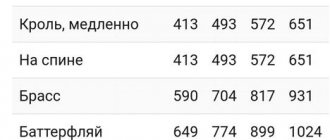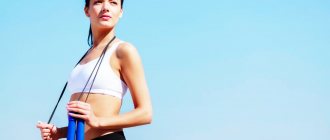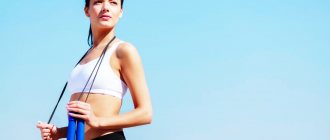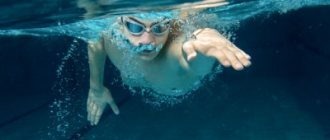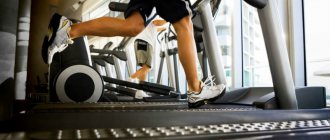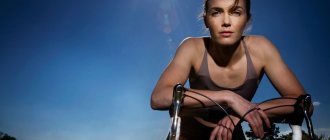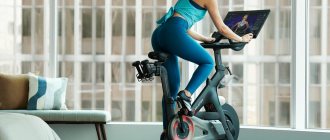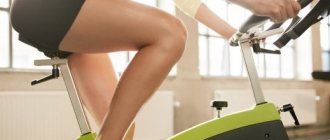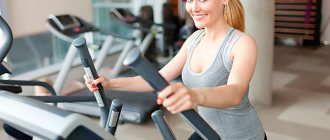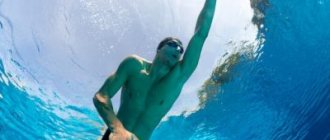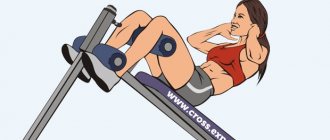Swimming is an effective method for developing endurance and muscle mass. Thanks to the resistance of water, the muscles receive a load that is distributed throughout the body and affects the body, creating harmoniously developed muscles. Swimming is also a powerful fat-burning workout, because even without movement, a person expends energy to stay afloat. Discipline is also considered the safest sport and strengthens the body. A pool training program can solve your problems not only with excess weight, lift your mood and improve muscle tone, but also cure some diseases of the spine.
Does swimming help you lose weight?
Athletes and nutritionists claim that the pool helps you lose weight if you follow the technique. Due to minimal joint load and the use of different muscle groups during movement, the body becomes flexible and sculpted, and loses extra pounds. Swimming and losing weight are compatible things - the process removes stress from the spine, strengthens posture and feet due to the active movement of the legs.
The benefits of swimming for the body are obvious:
- prevention of flat feet;
- stimulating lung function;
- keeps pregnant women in shape;
- water has a massage effect.
To lose weight, you need to swim properly - so that you get tired. During swims, monitor your heart rate (120-150 beats per minute), and each subsequent session increase the distance covered. Exercise correctly at 24-28 degrees of water; at lower temperatures, the body does not allow subcutaneous fat to be consumed (it is stored for thermal insulation). To lose weight in cold water, you will have to move more intensely.
Contraindications for visiting the pool:
- epilepsy, tuberculosis;
- ischemia;
- chronic nephritis;
- venereal, purulent, contagious skin diseases;
- thyrotoxicosis;
- lichen, ichthyosis;
- conjunctivitis, glaucoma;
- hypertension, atherosclerosis;
- arrhythmia, heart failure.
The benefits of a swimming pool for weight loss
The benefits of a swimming pool for weight loss are great, especially for girls. Regular weekly exercises will help tighten your figure, give your body definition and flexibility. The pool allows you to burn a quarter more calories compared to running, due to the resistance of the water. An hour of swimming in warm water consumes up to 600 calories, provided there is continuity of movement. Also, the intensity of fat burning has a direct dependence on the swimming style and initial weight (fat people lose weight faster): crawl burns up to 500 kcal, backstroke - 560, breaststroke - 520, and butterfly - 570.
To ensure that swimming in the pool for weight loss brings only benefits, use the following tips:
- correctly alternate styles and speed to work the whole body;
- start your classes with a warm-up - warm up for 10 minutes on land and five in the water;
- speed up at the beginning of the workout, slow down towards the end to relax and restore breathing activity;
- Spend half an hour on your first lessons, gradually increase the time to an hour;
- swim properly in the pool 3-4 times weekly;
- to fight cellulite, use a swimming board or inflatable ball;
- increase the load with water aerobics exercises;
- After the pool, it is correct not to eat for an hour and a half in order to lose weight faster.
Find out more about our weight loss programs:
The main thing is not to go to extremes. You cannot eat less than 800 kcal. The body will decide that hunger has begun and will slow down all metabolic processes. Losing weight will go slower. During the weight loss course, our specialists will tell you about all the intricacies of a healthy, balanced diet, teach you to listen to your body and explain how to combine physical activity with a new diet.
How to learn to swim in a pool
Those who want to maintain a slim figure should learn how to properly learn to swim in a pool in order to lose weight. Learning to float requires only desire - skills can be acquired at any age. A pool for learning to swim is ideal - choose one with a shallow bottom so that you can feel the hard surface with your feet. It is better to study under the supervision of a trainer.
Losing weight in the pool requires swimming training, which consists of the following principles:
- Breathe correctly - inhale deeply through your mouth, exhale into the water. There is no need to fill your lungs completely - this interferes with movement. To practice, try while standing in the shallows, take a deep breath, dive completely under water and exhale through your mouth. Float above the water and breathe through your mouth - droplets from the nasopharynx can enter the lungs, causing suffocation. Breathing should be controlled by the strokes of the limbs.
- Staying on the water - the “star” exercise will help. Take a breath, lower your face into the water, spread your limbs to the sides in the shape of a star. Stay in the position as long as possible without exhaling. The same technique will help you overcome your fear of water.
- We teach the movements of the arms and legs - hold your socks outstretched, hit them hard on the water. The speed of movement depends on the speed of the blows. To train your legs, use support (the side of the pool, a floating object).
What equipment do you need?
In the vast majority of sports clubs and municipal swimming pools, visitors are required to have a single mandatory set of equipment. This:
Bathing suit .
It should be a comfortable item of clothing that does not restrict movement. For men, these are classic swimming trunks or boxers; for women, a one-piece suit with wide straps.It is also worth making sure that the material does not deteriorate when in contact with water and chemical impurities in it.
- Cap. It is needed to prevent hair from getting into the pool, and also protects the scalp from the harmful effects of reagents. It is advisable to purchase a silicone cap. It stretches better and is easy to put on and take off. Latex caps are less practical.
- Glasses. Until recently, goggles were not mandatory equipment for non-professional swimmers. Buy a better training option. The so-called “starter” ones are not intended for long-term training.
- Rubber slippers . In the locker room, in the shower and on the path to the pool, visitors must wear rubber “bath” slippers. There are two reasons - to prevent slipping on wet tiles and to protect other visitors from possible pathogens.
- Towel and personal hygiene products . After the pool, be sure to take a shower with soap, and then dry your body well and dry your head.
Optional equipment that you can purchase yourself and bring with you to training includes: fins, a snorkel for breathing underwater, rubberized earplugs, a swimming board, an inflatable ring and arm pads.
For children who are not yet able to walk independently, there are special diapers and panties for the pool.
How to swim in the pool to lose weight
Those planning to lose extra pounds will need information on how to properly swim in the pool to lose weight. From the moment you learn how to stay afloat and the simplest methods of moving on the surface, move on to learning styles that actively promote fat burning. You can master everything at once, change styles at regular intervals. To lose weight in your legs, you need to swim breaststroke, your stomach - crawl, your whole body - on your back.
Swimming and losing weight require the following recommendations:
- exercise on an empty stomach (at least 2.5 hours should pass after eating);
- train correctly from 16 to 19 hours;
- before diving, take a warm shower and do a short warm-up;
- It is correct to visit the pool three times a week in order to get used to the stress, maintain acquired skills, and achieve weight loss.
Where to sign up?
In fact, even in large cities there are not so many options for which pool to sign up for. Yes, now there are quite large complexes, like Gazprom Arena or Sport-Max, but usually they are dispersed throughout the city , and getting to any of them is extremely difficult.
However, you shouldn’t waste your money on the pool closest to your home. It is advisable to pay attention to the following nuances:
- Attendance . If it is possible to go during strictly designated hours and days, it is worth asking the administrator how busy the paths are at this time.
- Pool size . How many lanes, what is the length and depth of the pool. For beginners it doesn’t matter much, but with experience it can become a critical factor.
- Water temperature . Today there are heated swimming pools. It’s also worth finding out how things are going with heating rooms in winter.
- Pool finishing . The swimming bowl can be finished with special tiles, film, mosaic, polypropylene and fiberglass. A good pool is always tiled with an anti-slip coating.
- Water exchange . The water in the pool can be circulated and purified through a filter, it can simply be changed every few days (you have to take my word for it) or a flow-through system is used. Best of all, water is purified in pools with water recirculation.
And the most important point is how water is disinfected, since no one is immune from allergies these days.
Most sports complexes offer the opportunity to purchase a one-time lesson (or it may be provided for free). Don't miss this chance to thoroughly familiarize yourself with the location.
Swimming styles in the pool
To practice properly, you should master swimming styles in the pool. It is ideal to ask a coach to teach you how to swim to increase the effectiveness of your lessons. The main physical styles are:
- Breaststroke - on the chest with limb strokes parallel to the surface of the water. Slow type, works the legs, buttocks, shoulders, chest, back.
- On the back - arms move straight on the water. The method works the shoulders, chest, back, and calf muscles. Cannot put stress on the spine.
- Butterfly (dolphin) is the most difficult style, requires a certain level of training, and is performed on the stomach. The difference from breaststroke is the work of the arms - they move symmetrically. The limbs row powerfully with pushes, lifting the body above the water, the pelvis and legs make wave-like movements. The load falls on the shoulders, chest, back, abdomen, hips, deltoid and calf muscles.
Frog swimming
The most ineffective style is considered to be frog swimming. This will not help you lose weight, plus it brings danger in the form of strain on your neck and shoulders - your head is always above the water. Because of this, the muscles can become tight and painful, which can only be corrected with a specialized therapeutic massage. The frog style is not able to load the body evenly; no one will be able to achieve weight loss with it.
- Blepharoplasty of eyelids
- Organic farming in the country from scratch - video. Where to start with natural farming and building smart beds
- Diet for psoriasis - menu with recipes. Diet and products for the treatment of psoriasis
Crawl
The simplest and most easy to learn swimming style is the crawl. Lie face down in the water and take turns rowing your legs up and down. At the same time, make movements with your hands - bring one forward, lower it into the water, fold your palm into a ladle and row it towards your thigh. Repeat the technique with the other hand. Breathing is done by lifting your head out of the water on every second stroke, while turning your face towards your hand under water. Breathe as deeply as possible. The crawl uses the broad muscles of the chest, back, shoulders, and hips.
Stretching and Cooling Down
As important as warming up before a workout is, completing it correctly is just as important. After completing the main set of exercises, there is always a stretching block and a cool-down.
This block evenly distributes the load on the muscles, develops flexibility and elasticity of the body, has a relaxing effect on the joints, and prevents injury.
The following exercise is performed as a stretch and cool-down. You need to lie on your back in the water, spread your straight legs and arms to the sides, and lie in this position for several minutes. To stretch, you need to secure your foot to the noodle and first straighten one leg, then do the same with the other.
Pool training program
The training program in the pool lasts from 45 minutes correctly, repeating three times a week with a gradual increase in load. For beginners, the following scheme is suitable: breaststroke three times, rest for half a minute, back crawl three times, rest, front crawl three times. Trainers should advise everyone else on how to swim to lose weight. To increase the load, do exercises underwater, alternate styles. If you are very tired, rest longer, but do not stand in the water, but swim slowly. Determine the result and follow a schedule to achieve it.
Average level
Breath control and endurance
Distance – 900 meters, freestyle training:
- warm-up 2 x 100 meters with one break in the middle;
- 4 x 25 fast crawl with 30 seconds rest between segments;
- 4 x 50 with three strokes on each stroke and a 15-second rest after every 50 meters;
- 4 x 25 fast with holding your breath during the segment and a 30-second rest after;
- 4 x 50 with three strokes on each stroke and a 15-second rest after each half hundred;
- cool down 100 meters.
All styles
Distance – 900 meters, plan:
- warm-up with crawl 2 x 100 with rest at your discretion;
- 4 x 25 on the back with breaks of 15 seconds;
- 4 x 25 breaststroke with breaks;
- 4 x 25 butterfly with breaks;
- 2 100 in turn - 25 in each style with a break of 30 seconds after a hundred;
- cool down with freestyle 200 meters.
Krol + complex
Distance – 1000 meters, plan:
- warm-up 200 without a break;
- 4 x 50 freestyle with alternating speeds every 25 meters and resting for 15 seconds;
- 4 x 100 alternately - 25 meters in each style with a break of 30 seconds after a hundred;
- cool down 200 meters.
Krol + complex No. 2
Distance – 1000 meters, plan:
- warm-up with freestyle 100 meters without a break;
- 4 x 50 alternately butterfly and crawl every 25 meters and a 30-second break after every 50 meters;
- 4 x 50 – back and crawl;
- 4 x 50 – breaststroke and crawl;
- 4 x 50 freestyle with alternating speeds every 25 and rest;
- 100 meter freestyle cool down.
Endurance, breathing rhythm, turning technique
Option 1
Distance – 1200 with added turns, plan:
- warm-up crawl 300 meters without rest;
- 4 x 50 freestyle with alternating breathing - inhaling on the 4th stroke in the first 25 meters and on the 2nd stroke in the next 25 meters with a rest of 15 seconds;
- 200 freestyle followed by 10 turns after every second stroke;
- 4 x 50 in any style at your discretion with a break;
- 300m freestyle cool down.
Option 2
Distance – 1200 with added turns, plan:
- warm-up crawl 200 without rest;
- 200 freestyle followed by 4 turns after every fourth stroke;
- 4 x 100 freestyle, inhaling on the fourth stroke and resting 15 seconds after the segment;
- 4 turns after every fourth stroke;
- 4 x 50 in any style at your discretion with a short break;
- cool down 200 meters freestyle.
Swimming exercises in the pool
To further increase the effectiveness and efficiency of weight loss, there are exercises for swimming in the pool from aqua aerobics:
- Running - go waist-deep into the pool, run in place, holding the side and raising your knees high. Number of repetitions – up to 15 times.
- Jumping - jump, moving on different sides alternately. You can jump in place, raising your knees to your chest, keeping your abs tense.
- Jumping – Jump on one leg at a time without jumping out of the water.
- Jumps for the inner thigh - on two counts: legs together and apart, as high as possible.
- Swings – go up to your chest, slowly raise your legs, touching your hands.
- For the stomach - sit on the bottom in a shallow place, rest your hands behind you, do the “scissors” exercise.
- Triceps – stand with your back to the side, rest your hands and elbows on the edge, slowly lower and raise your body. The rise should be sharp and the descent should be slow.
- Bicycle – lie down on the water, spin imaginary pedals with your feet, press your elbows to your body.
- For the waist - stand at the side, raise your straight legs to the sides and back. Make it more difficult by raising your arm above your head and bending to the sides.
- With dumbbells – extend your arms above your head and bend over. Try to make short, springy, circular movements.
For thighs and buttocks
Effective exercises for the buttocks pump and strengthen the muscles of the thighs and legs, helping to get rid of cellulite in a short period of time. These types of exercises will also help relax your back muscles. This complex includes the following exercises:
- Stand facing the pool railings, grab them with your hands to fix your body in a static position. Raise your leg up, hold it straight for 5 seconds, and slowly lower it. Then you need to do the exercise with the other leg.
- From the starting position of the body (as in the previous exercise), raise your leg and make several swings with it - 3 sets of 5 times. Your back should always remain straight during the exercise.
- Jumping is the best exercise for the gluteal muscles and thighs, especially when done in water. Do a shallow squat in the water, placing your arms along your body. Push off from the bottom of the pool as hard as possible; during the jump, you should try to spread your legs as wide as possible to the sides. The number of approaches should be increased gradually.
Water procedures such as running in place for a few minutes or running backwards will help to work out the buttock area. Another effective exercise is to bend your legs slightly at the knees and pull them towards your chest; the duration of the exercise is 2-3 minutes.
How to swim to lose belly fat
The majority of women who visit the pool are interested in how to swim to get rid of their belly fat. The ideal style for getting a thin waist and flat tummy is the crawl style. It affects the oblique muscles of the upper abs, forcing them to work and burn fat. The special water aerobics exercises described above will help increase the effect. They need to be done in the middle of the lesson to avoid fatigue.
To get an ideal body from the pool, it is correct to use the following training scheme, developed by qualified trainers. According to her, in three months the stomach will look flat and the waist will look chiseled. Rest between swims should be taken as you become tired.
| Week/Distance, meters | 1 day | Day 2 | Day 3 |
| 1 | 200 | 200 | 200 |
| 2 | 300 | 300 | 300 |
| 3 | 400 | 400 | 400 |
| 4 | 400 | 400 | 400 |
| 5 | 400 | 500 | 500 |
| 6 | 500 | 500 | 500 |
| 7 | 500 | 500 | 500 |
| 8 | 500 | 500 | 500 |
| 9 | 600 | 500 | 500 |
| 10 | 600 | 500 | 500 |
| 11 | 700 | 500 | 500 |
| 12 | 700 | 500 | 500 |
For the back
For the muscular corset of the back, you need to exercise in such a way that the load falls evenly on its entire surface. The arm muscles are also involved in the exercise.
Stand in the water, immersed up to your neck, spread your arms in different directions, try to move them as far as possible, feeling the tension in your shoulder blades.
After this warm-up, you can proceed to the next exercise - stand in water up to your neck and perform movements with your hands that imitate swimming in various styles. It is important to gradually increase the speed of movements.
Contraindications for exercise
Before you decide to lose weight through exercise in the pool, you must definitely visit a doctor, since there are contraindications to this type of exercise. Restrictions include:
- Acute viral and infectious diseases.
- The presence of inflammatory processes in the organs of the genitourinary system.
- Recent injuries.
- Recent surgical interventions.
You cannot exercise if you have a fungus, skin diseases of various etiologies, or an allergic reaction to chlorine. If there are no contraindications to exercise, you can and should exercise in the pool. This type of exercise for weight loss is the most effective, the main thing is to combine it with proper nutrition.
Water aerobics for weight loss
How to do water aerobics for weight loss?
When you need to slightly adjust your figure, achieve general strengthening of the body, and bring muscles to normal tone, you need to go to the pool 2-3 times a week. If you are concerned about large amounts of excess fat, then a set of exercises in water will have to be done 4 times a week and must be combined with a diet for weight loss. A good effect in the first and second cases can be seen after 3 months of regular visits to the pool. One lesson lasts 30-45 minutes.
It's right to start with a warm-up, this can be jumping or running in the water, swinging your legs, raising your legs, or anything to warm up your body. During exercise, it is important to keep your stomach pulled in and your back perfectly straight. At the end of the workout, it is customary to stretch. Before training, it’s good to take a cool shower. It is also important to exercise in the pool on an empty stomach; for this you need to abstain from food for 1.5-2 hours.
Accessories for water aerobics
Mandatory equipment includes special shoes, a one-piece swimsuit, swimming goggles and a rubber cap. In water they practice with balls, gloves, barbells and dumbbells; they are used to increase the load. If you do not have swimming skills, you can wear a belt that supports your body in the water.
Who is contraindicated for water aerobics?
It is advisable to change classes in the pool to another suitable type of physical education for these ailments:
- cystitis;
- asthma;
- cold;
- problems with the vestibular system;
- viral disease;
- convulsions;
- genital infection;
- heart diseases.
